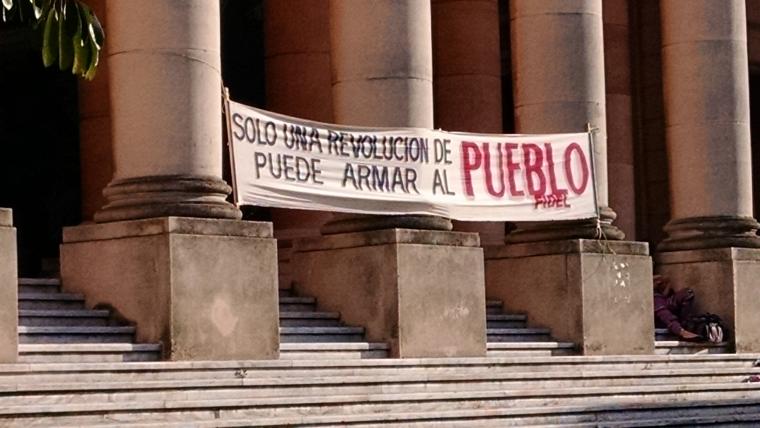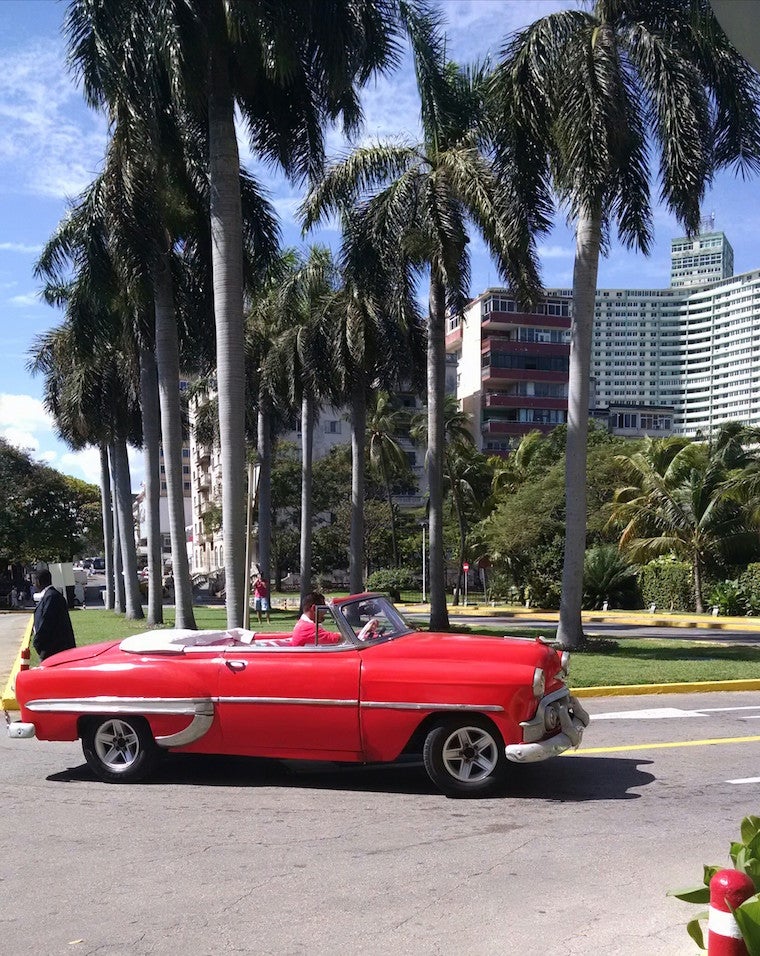Campus News
Advancing Academic Exchange with Cuba
November 18, 2015
Lisa Gulasy

A sign hangs outside of a building at the University of Havana. Photo courtesy of Ellen Sayles.
Since the early 1960s, travel restrictions have greatly limited Americans’ ability to visit Cuba, making an American student’s desire to study abroad in the country just more than 100 miles south of Key West, Florida, extremely challenging. In recent months, however, a number of students, faculty, staff, and alumni have gained access into Cuba to study life and culture in the socialist nation.
David Kamitsuka, associate dean of the curriculum for the College of Arts and Sciences and associate professor of religion, and Ellen Sayles, associate dean of studies and director of programs for international study, are the two most recent travelers to Cuba from the Oberlin community. Their visit has the potential to pave the way for even more Obies to enter the country where fewer than 2,000 American students study each year.
Kamitsuka and Sayles traveled to Cuba as part of a delegation from 12 colleges and universities organized by the nonprofit Institute of International Education (IIE) as part of its broader IIE Cuba Higher Education Initiative. According to Sayles, the purpose of the delegation was to help the U.S. representatives better understand Cuban higher education and to meet important university and ministry representatives who could help facilitate future partnerships.
“This trip was about figuring out ways to establish stronger educational ties in Cuba now that the political landscape is changing between the U.S. and Cuba,” Sayles says. “The trip was not intended to actually form partnerships but to help us understand the educational layout and meet the important people.”
Those people included acting Ambassador of the United States to Cuba Jeffrey DeLaurentis; Margaret Crahan, director of the Cuba Program at the Institute of Latin American Studies at Columbia University, who is on the advisory board for the IIE Cuba Higher Education Initiative and is serving as a mentor to Oberlin College in the months moving forward; and rectors (presidents) and faculty from the University of Havana and the Instituto Superior de Arte Cuba.

“The American ambassador, whom we met with twice, told our group he expects substantial changes in U.S.-Cuban relations in the next year,” Kamitsuka says. “He said his goal is to make the deepening of collaboration and exchange between the U.S. and Cuba an ‘irreversible process.’”
Now that Sayles and Kamitsuka have returned to the states, the next step in building connections with Cuban universities is to determine how the college can best advance academic exchange and joint research focused on enhancing understanding of one another’s cultures and addressing issues of mutual interest.
“We have a small working group that includes faculty who have interest in Cuba as part of their research or scholarly focus. We will be working with that group to figure out how we want to go forward. What type of partnerships are the Cuban institutions interested in pursuing? Are there curricular initiatives that could involve Cuba? Do we want to develop more winter-term trips? Do we want to invite researchers to come here? We have a lot to think about and a lot to explore,” Sayles says.
Both Sayles and Kamitsuka emphasize that developing the college’s strategic plan for partnering with Cuban universities will be a lengthy process. “We were told repeatedly that we can’t expect things to happen quickly. We have to work carefully, and you have to know what it is you really hope to gain from a partnership and how a partnership will benefit the university in Cuba as well,” Sayles says. She estimates the working group will likely have a better idea of the college’s study abroad strategy for Cuba by the end of the academic year.
However, that doesn’t mean students do not have opportunities to study in Cuba now. “The higher education policy on students going to study in Cuba was changed a year ago, and so more students have been going to Cuba for semester programs. We have two students there now and four going next semester,” Sayles says. There is also a proposed winter-term trip in 2016-17 called Reimagining Havana with Professor of Hispanic Studies Ana Cara.
“Cuba is in a moment of great promise and great uncertainty. Students who study in Cuba will be eyewitnesses to real national transformation. I’m hopeful that we can establish relationships with institutions in the next few years because that is a wonderful opportunity,” Kamitsuka says.
For more information on studying in Cuba as well as other international destinations, see the Office of Study Away website.
You may also like…
Michael Rainaldi Honored with YB Staff Award
Rainaldi’s leadership and dedication to students is one of the reasons he was selected for the award.
A Conversation with Leo Hochberg: Student Research in Lebanon
The senior politics and Middle Eastern studies double major's experience in Lebanon culminated in a 23-page report examining the Syrian refugee crisis.

